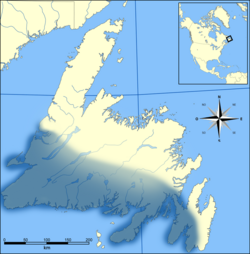
Back Terre-Neuve (Nouvelle-France) French Colonia di Plaisance Italian Ньюфаундленд (Новая Франция) Russian
Terre-Neuve | |||||||||||
|---|---|---|---|---|---|---|---|---|---|---|---|
| 1658–1713[1] | |||||||||||
|
Flag | |||||||||||
 Terre-Neuve roughly covered the southern half of Newfoundland | |||||||||||
| Status | Colony of France within New France | ||||||||||
| Capital | Placentia | ||||||||||
| Common languages | French | ||||||||||
| Religion | Catholic Church (state religion) | ||||||||||
| Government | Monarchy | ||||||||||
| King | |||||||||||
| Governor | |||||||||||
| History | |||||||||||
• First Governor | 1658 | ||||||||||
• Founding of Placentia | 1662[2] | ||||||||||
| 1713[1] | |||||||||||
| Currency | New France livre | ||||||||||
| |||||||||||
| Today part of | Canada, France | ||||||||||
Terre-Neuve ("Newfoundland") was a colony in New France that existed from 1655 to 1713, and which consisted of the southern portion of Newfoundland island (the northern portion being claimed by England). The most, and sometimes only, populated region was Placentia, called "Plaisance" in French. Because of Placentia's geographic position, its main economic activity was fishing, and the settlement could serve as a pit stop for ships traveling to and from France and other New France colonies like Canada or Acadia. Terre-Neuve ceased to exist in 1713, when France evacuated its settlers and transplanted them to Cape Breton. But, France regained the Saint Pierre and Miquelon islands of this colony in 1763, and still has possession over them today.
- ^ "Treaty of Utrecht | The Canadian Encyclopedia". www.thecanadianencyclopedia.ca. Retrieved 28 December 2022.
- ^ "The French Settlement of Placentia". www.heritage.nf.ca. Retrieved 28 December 2022.
© MMXXIII Rich X Search. We shall prevail. All rights reserved. Rich X Search
